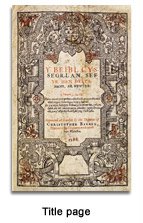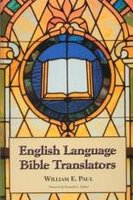BIBLE COLLECTOR'S BLOG
For collectors of translations, versions and editions of the Bible. Companion to The Bible Collectors Directory: the most comprehensive collection of links to Bibles and resources for Bible collectors on the Web.
Historical Catalogue Of The Printed Editions Of Holy Scripture In The Library Of The British And Foreign Bible Society
 Reprint of the 1903-11 first edition, four volumes bound in two. (Besterman 759, Breslauer & Folter 23).
Reprint of the 1903-11 first edition, four volumes bound in two. (Besterman 759, Breslauer & Folter 23).An irreplaceable catalogue of the editions of the bible arranged chronologically under each language. Over 9,848 annotated entries with over 600 languages included.
This is the single most important reference source for Bible collectors and very much recommended. Collectors of the English Bible will however be better served by the 1968 update on that section by A.S. Herbert.
A Bible For Wales
 The year 1588 saw the publication of the first Welsh translation of the complete Bible, including the Apocrypha. It was the work of William Morgan, 1545-1604, a native of Penmachno, Conwy and a graduate of St. John's College, Cambridge. This folio volume was printed in black letter by the deputies of Christopher Barker, the Queen's Printer. It was intended for church rather than home use. At the time of the Acts of Union (1536 and 1542), few Welshmen or women could have foreseen the publication of a Welsh Bible before the end of the century. Several factors made this unlikely. Welsh had been denied official status and had been banned from the spheres of law and administration. Furthermore it had been decreed that the English Bible and Book of Common Prayer were to be read in every church in the land. The bardic order, the traditional guardian of the literary language, was also in decline. It was probable that the language would deteriorate into a despised collection of dialects and eventually die. The fact that it did not do so is largely due to the efforts of a group of Welsh scholars imbued with enthusiasm for the humanistic learning of the Renaissance. Most were Protestants driven by a Protestant zeal for making the Scriptures available to all. Men steeped in classical learning, they also dreamt of seeing the vernacular safeguarded and elevated to the status of a learned language. Their dictionaries, grammars, and scriptural translations, of which the 1588 Bible is the supreme example, went far to turn this dream into reality.
The year 1588 saw the publication of the first Welsh translation of the complete Bible, including the Apocrypha. It was the work of William Morgan, 1545-1604, a native of Penmachno, Conwy and a graduate of St. John's College, Cambridge. This folio volume was printed in black letter by the deputies of Christopher Barker, the Queen's Printer. It was intended for church rather than home use. At the time of the Acts of Union (1536 and 1542), few Welshmen or women could have foreseen the publication of a Welsh Bible before the end of the century. Several factors made this unlikely. Welsh had been denied official status and had been banned from the spheres of law and administration. Furthermore it had been decreed that the English Bible and Book of Common Prayer were to be read in every church in the land. The bardic order, the traditional guardian of the literary language, was also in decline. It was probable that the language would deteriorate into a despised collection of dialects and eventually die. The fact that it did not do so is largely due to the efforts of a group of Welsh scholars imbued with enthusiasm for the humanistic learning of the Renaissance. Most were Protestants driven by a Protestant zeal for making the Scriptures available to all. Men steeped in classical learning, they also dreamt of seeing the vernacular safeguarded and elevated to the status of a learned language. Their dictionaries, grammars, and scriptural translations, of which the 1588 Bible is the supreme example, went far to turn this dream into reality.You may view a digital facsimile copy here.
The Scriptures Translation
 The Scriptures by the Institute for Scripture Research: "The divine Name (the tetragrammaton), YHWH, appears in Hebrew characters throughout the translation in the Tanakh (Torah, Nevi'im, Kethuvim) and also in the Messianic Scriptures. The name by which the Messiah was known, Y'hoshua/Yeshua, is restored in Hebrew as well and appears in the text as such, The original Hebrew personal names of people and places are restored throughout the Scriptures, such as 'Yirmeyahu' for Jeremiah, 'Yeshayahu', for Isaiah and 'Mosheh' for Moses and in the Messianic Scriptures, 'Mattithyahu' for Matthew etc. Words and names, as far as possible, have been corrected in order to eliminate any names of idolatrous origin. The books in the Tanakh are arranged according to the original order of the Hebrew Scriptures, the Torah, the Prophets and the Writings. Difficult phrases in the Scriptures are explained in footnotes and the explanatory word list."
The Scriptures by the Institute for Scripture Research: "The divine Name (the tetragrammaton), YHWH, appears in Hebrew characters throughout the translation in the Tanakh (Torah, Nevi'im, Kethuvim) and also in the Messianic Scriptures. The name by which the Messiah was known, Y'hoshua/Yeshua, is restored in Hebrew as well and appears in the text as such, The original Hebrew personal names of people and places are restored throughout the Scriptures, such as 'Yirmeyahu' for Jeremiah, 'Yeshayahu', for Isaiah and 'Mosheh' for Moses and in the Messianic Scriptures, 'Mattithyahu' for Matthew etc. Words and names, as far as possible, have been corrected in order to eliminate any names of idolatrous origin. The books in the Tanakh are arranged according to the original order of the Hebrew Scriptures, the Torah, the Prophets and the Writings. Difficult phrases in the Scriptures are explained in footnotes and the explanatory word list."The translation may also be accessed online here.
Unique Reference Work About English Bible Translators
 The book English Language Bible Translators by William E. Paul (2003) is an excellent reference work that provides information about many of the men and women involved in producing an English language translation.
The book English Language Bible Translators by William E. Paul (2003) is an excellent reference work that provides information about many of the men and women involved in producing an English language translation.Arranged alphabetically by surname, each of the 346 entries includes the individual’s year of birth and death, place of birth, educational attainments, positions or occupations, and literary accomplishments; notes on various editions produced; samples of their translation; and other pertinent facts. In cases where translations were done by committee, the chairpersons and project initiators are covered.
Important anonymous translations are also included, and arranged under the version's name. The work is indexed, including those names of committee-level translators covered in a chairperson’s entry.
The author is the chief editor of Bible Editions & Versions: The Journal of the International Society of Bible Collectors. This reference work is truly a "must" for collectors of the Bible in English.